Archaeology and the Bible
Genesis - 2
| Ur | 30 57 45.75N 46 06 11.17E | This is a splendid picture of the ruins of Ur, though it is worth zooming out a bit to see the dark area of the ruins, shaped a bit like a short, fat aubergine. If you switch on 3D Buildings you get some idea of the ziggurat. |
| Urfa | 37 08 52.23N 38 47 05.69E | This is claimed by Muslims to be the birthplace of Abraham. The pointer should be directly over the mosque which marks the birthplace, with the ancient citadel just to the south of it. |
| Haran | 36 51 53.89N 39 01 53.79E | The large tel is clearly visible, together with some excavations on the summit. However if the photographs are to be believed, the only visible ruins are Islamic in date. |
| Sahel | 24 03 26.81N 32 52 24.09E | The pointer is in the approximate position of the "Hungry Rock" on Sahel Island. You can see boats at the landing stage to the north-east. |
| Bani Hasan | 27 55 51.97N 30 52 30.20E | The pointer is directly above some of the cliff tombs at Bani Hasan. The path, running south along the row of tombs and then dropping east down to the ticket office, can be clearly seen. |
Abraham
The first question we need to consider is where Abraham came from. The Bible states that he was born in "Ur of the Chaldees" (Genesis 11:28); the Chaldees or Chaldeans were a tribe in southern Mesopotamia and so it is assumed that the Ur in question is the city of that name in southern Iraq. When Sir Leonard Woolley excavated the ruins, he identified a particular stratum as coming from the presumed time of Abraham (c. 1800 BC in conventional chronology) and picked on a typical house to be "Abraham's House". Guides in Ur still point it out by that name.
This is the accepted birthplace of Abraham and in addition to the "of the Chaldees" there is another pointer towards this site. David Rohl, in his book Legend suggests that the Sumerian god Ea is the origin of the "Jah" of the Old Testament. Not only are the sounds virtually identical, but we believe that the true God had been worshipped by Noah and his sons, so why should His name not be remembered, even if His true nature was obscured by layers of heathen mythology?
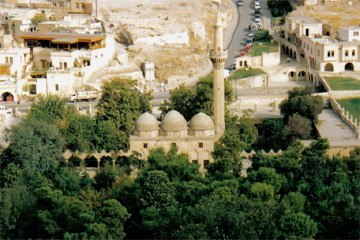
|
| The mosque in the foreground stands over a cave, claimed by Muslims to be the birthplace of Abraham. |
On the other hand there are several points which would lead away from the Ur in southern Iraq. The racial origins of the Sumerians are not known, but they are presumed not to be Semites - and Abraham was definitely a descendant of Shem. It is possible, of course, that Terah was a Semite who had moved to Ur for the commercial advantages it offered.
Sumerian, the language of Ur, is not related to any other known language, so it is odd to think that Abraham's native language may have been Sumerian, not Hebrew! More to the point, the names we have found for Sumerian people are nothing like the Semitic names in the Bible: Mes-kalam-dug, Shub-ad, Puabi or Mes-Anni-Padda.
By contrast, the Ebla tablets reveal a language with distinct links to Hebrew and refer to individuals with names such as "Adam", "Eve", "David", "Abraham", "Jacob" and "Job". The Ebla tablets also refer to an "Ur" which appears to be identical with modern Urfa near the border between Turkey and Syria. Urfa is the traditional birthplace of Abraham - though how far back the tradition extends is uncertain. It is possible that the appellation "of the Chaldees" could refer to a trading colony in the city.
If Urfa was the "Ur of the Chaldees", then Terah's great leap of faith in traveling to Haran is really quite contemptible: Haran is only about 25 miles from Urfa! On the other hand, Haran is on the route from Urfa to Canaan whereas it would be very out-of-the-way for someone travelling from the southern Ur to Canaan.
The Habiru
Abraham is referred to as "the Hebrew" and it is tempting to identify this with the "Habiru" mentioned in various sources. When the name was first discovered in the Amarna Tablets many people supposed that
the reference was to the Children of Israel invading the Promised Land, but since then other texts have been found that make it plain that the Habiru were a separate people or class of people, part mercenary soldiers, part freebooters, who were alternately used and abused by the petty kings of Syria and Palestine in their wars with each other. To call someone a Habiru was not a compliment!
It is interesting that Abraham is called "the Hebrew" or "the Habiru" in connection with the rescue of Lot. He said to have had 318 trained men in his encampment, with whom he undertook a forced march followed by a highly professional night attack - even today a difficult military manoeuvre - that scattered the much larger forces of the Mesopotamian kings and achieved its purpose of rescuing Lot. 318 armed and trained retainers appears a little excessive for a simple pastoralist! If Abraham was a Habiru, he must have been a a successful one and the little episode described can only have enhanced his reputation in the area.
On the other hand, it is hard to think of "the Friend of God" being a hired sword, a leader of a band of mercenaries, yet that would explain the eagerness displayed by both Pharaoh of Egypt and Abimelech of Gerar to be allied to Abraham and the politeness with which both rulers sent him away after the little deception over Sarah had been discovered.
A more serious problem is that the earliest reference to the Habiru dates to around 1850 BC by conventional chronology, which would be 600 years too late for a Revised Chronology. Of course it might be that Abraham was the original Habiru - Bible scholars usually view "Hebrew" as a reference to descent from Eber, one of the ancestors of Abraham - and that the name gradually spread to other warrior bands, but if that is so it is hard to think of six centuries passing before the name entered general use. In other words, if "Hebrew" and "Habiru" are related, then the name must be viewed as evidence against the Revised Chronology.
In previous times some proposed that Amraphel, mentioned in Genesis 14, is the same as Hammurabi, the famous Mesopotamian king. This identification is no longer accepted. However the discovery of inscriptions in the ancient Elamite language mean that we can recognise the name of the Elamite king mentioned in that chapter as a genuine Elamite name - Kudur-lagamar. As rendered in the English Bible, the name appears as Chedorlaomer, but it should really be written Chedor-la`omer, with the ` symbol representing the Hebrew `ayin, a sound produced at the back of the throat and which sounds a little like a hard 'g'.
When Abraham wanted assurance that God would fulfil His promises to him, God instructed him to take several animals and cut them in half, placing the halves opposite each other and then running around and keeping the vultures at bay until nightfall, when a mysterious lamp appeared, blazing like a furnace, and passed between the divided animals.
A treaty between the conquering Hittite king and his defeated enemy speaks of an identical ceremony. Several different kinds of animals and an unfortunate man were killed and cut in half, then the defeated ruler was obliged to walk betwen the divided carcasses on his way to the Hittite king. The message was clear: if you break this treaty, this is what will be done to you: you will be killed and cut in half, like these animals and this man.
God, the Supreme Being, condescended to act the part of the defeated king and passed between the divided carcasses, in effect saying, "If I do not fulfil My promise, this what you can do to Me."
The Nuzi Culture
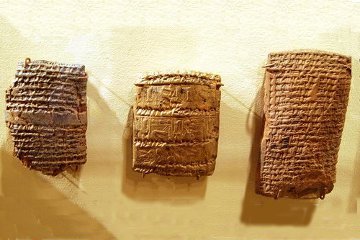
| |
| Three tablets from Nuzi in the Semitic Museum, Harvard. |
We might wish that Abraham had held to a higher morality than the culture about him, but the behaviour of godly people, including Christians, has too often conformed to the ethics of the prevailing culture. For example, in America Christians own guns and are vocal in their opposition to abortion (you mustn't kill someone before they are born but afterwards is ok); in Britain Christians are more reasonable about abortion but are horrified at the thought of owning or using a gun.
The Nuzi Tablets also authorise a childless couple to purchase a slave and bring him up as their son and make him their heir. Abraham refers to this when he laments that his slave, Eliezer, is his nominated heir. Such adoptions offered mutual responsibilities: the adopted father was supposed to care for the "son" and leave him his goods (the rights of a natural son did, however, take precedence), and the "son" was supposed to honour and care for his parents during their lifetimes and give them an honourable burial on their deaths.
Eliezer was subsequently sent to Haran in search of a wife for Isaac and the Bible records that he travelled on camels. This has been considered an anachronism because, so the claim alleged, camels were not domesticated until very much later. Recent discoveries have disproved this argument however. There is no reason, therefore, to doubt that Abraham had camels - though it may have been their novelty that led him to consider them suitable transport for the journey to find a bride.
When Sarah died Abraham purchased for her grave the Cave of Machpelah. The traditional site of this cave is now in the middle of Hebron, but it is possible that in an earlier period the city was confined to the hill-top and the cave was at the end of a field just outside it. Israeli archaeologists and adventurers have entered the traditional cave (in secret, as the Muslims, who own the shrine, would be infuriated by such desecration). They report that there is nothing to see inside the cave and no remains that would allow it to be identified as the genuine cave or not.
Hittites and Philistines
It is surprising to find mention of "the sons of Heth" or Hittites. At this time the Hattians ruled in the area which was later conquered by the Hittites. Clearly Hebron was not part of the Hittite empire, but it is possible that it contained a colony of Hittite traders who had settled in the area in pursuit of business.
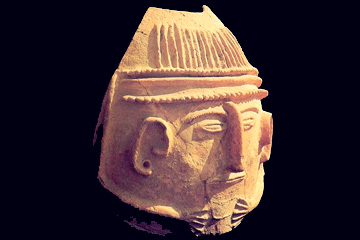
|
| Clay anthropoid sarcophagii are the hallmark of the Philistines. The headdress shown on this cover for a coffin is claimed to be identical to the headdresses of the "Sea Peoples" at Medinet Habu. |
More problematic are the references in Genesis to the Philistines. The Philistines are usually identified with the Peleset or "Peoples of the Sea" who invaded Egypt during the reign of Rameses III and were repulsed by him, after which it is thought that they settled down along the coastal plain of southern Palestine, to which country they gave their name. This is, of course, far too late for the time of Abraham and has led some to accuse the Bible author of an anachronism.
Others have pointed out that there appear to be two different groups known as "Philistines" - the people of Abraham's day and the people who appear in the Biblical record during the period of the Judges. This is confirmed by the Talmud (not the most reliable of sources, it has to be said) which states explicitly that the "Philistines" of Abraham's time were not the same people as the later Philistines.
Archaeology appears to show that the earlier Philistines were related to the Mycenaean Greeks and may have originated as a trading colony which gradually went native and formed a blended Greek-Semitic culture, which would be why the ruler with whom Abraham and Isaac negotiated was known by the Semitic title of "Abimelech" - "My Father is King". (Abimelech's companion, Phichol, is not a Semitic name and is thought to a genuine Philistine name or title.) A couple of Biblical references tell us that the Philistines came from Caphtor, which is probably the island of Crete. According to Deuteronomy 2:23 these invaders took over the land of another people known as the Avim. (It is not certain whether this is a reference to the Philistines of Abraham's time or the later ones.)
The later Philistines appear to have been related to the Minoans and some have speculated that the invasion of Egypt by what appears to have been a migrating people was the culmination of a series of people-movements as the refugees from the eruption of Santorini gradually worked their way round the Mediterranean. In view of the earlier date now accepted for the Santorini eruption, this seems very unlikely.
The final question is the date for Abraham. If the Exodus was in 1445 BC, then Abraham, who lived 430 years earlier, must have entered Canaan in 1875 BC. However if we push the Exodus back by 600 years (or bring secular history down by that amount), then Abraham would have been living in what conventional chronology calls 2475 BC. This would make him the contemporary of the Fifth Dynasty pharaohs of Egypt, whereas the conventional date would put him contemporary with Hammurabi of Mesopotamia.
Jacob
We pass over Isaac, whose story has nothing on which archaeology can throw any light, and turn to
Jacob. After shamefully deceiving his father Jacob fled to Haran and on the way spent a night near Bethel where he used a stone as a pillow, a contrivance which has usually be taken as indicating the extreme hardship he suffered on his escape. In fact, he probably used a stone pillow every night!
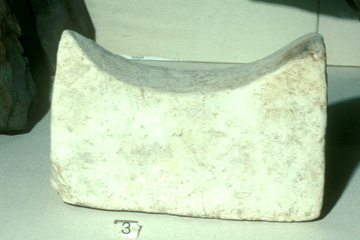
|
| A stone pillow from Kahun, now in the Manchester Museum. |
Among the objects discovered in the houses of Kahun were several stone blocks with the top surface carefully cut into a concave curve which may have been padded with a straw "mattress". These were pillows and it is interesting to note that although Tutankhamun's pillow was made of gold and more elegantly shaped, it was similarly hard. A pillow in those days was not for comfort: its purpose was to keep your head above the ground so that creepy-crawlies wouldn't get into your ears! It probably went under the neck, instead of the head as modern pillows do.
When Jacob arrived in Haran there is no mention of Laban's sons, so it is possible that Laban adopted Jacob as his heir - though if so, he was accepting him at the very lowest level, because only an adopted slave was expected to work before being given a daughter of the house as bride. A freeman who was adopted could expect a bride as part of the arrangement. An adoption would explain why Jacob felt it necessary to request Laban's permission to return to Palestine - and why Laban pursued after him when he did eventually sneak away.
It is notable that it was Laban's sons who voiced their envy of Jacob's wealth. If these were sons born after Jacob was adopted, although their rights of primogeniture were protected by law, nonetheless Jacob still had a claim on their father's estate - in addition to the wealth he amassed by his hard work. They resented the prospect of having to share with one who was already wealthy.
People in those days regarded the gods as extremely territorial and each house or plot of land had its own protective deity. The teraphim or images which represented these household gods were extremely important, for the person who held them also had control and ownership of the land and property they protected. Among the Nuzi Tablets were a number of wills in which the household teraphim were bequeathed to named individuals, carrying with them the property of the deceased person.
This is why Laban was so concerned to find the missing teraphim when he caught up with Jacob - and why Rachel was at such pains to steal them and keep them hidden. The two girls felt quite bitter about their brother's behaviour, complaining that "he has sold us and devoured our money" - in other words, he had appropriated the dowery money which should have been kept safe for them in the event that they were widowed or divorced. By stealing the teraphim Rachel had, in effect, taken Laban's houses and land.
Joseph
When we come to the story of Jacob's son Joseph we have a curious parallel in the Egyptian Tale of Two Brothers, in which the two brothers live together and the wife of the elder falls in love with the other. When her attempt to seduce him is rebuffed, she tears her clothes and paints bruises on her body, then accuses the younger brother of trying to rape her. Naturally critics of the Bible have claimed that the Biblical story is a rehash of the Egyptian tale, but given human nature there is no reason to conclude that two Egyptian woman might not have come up with the same idea independently.
Egypt has very little rainfall and is totally dependant on the Nile for irrigation. In pharaonic times, that meant the annual Nile flood. If the flood was low or failed altogether, then there was famine and there are many records of famines. However it was highly unusual for the Nile to fail for several years in succession and there are only a few references in Egypt to famines that endured for more than one year. One of these is in the tomb of Beba, who was governor of the now vanished town of Pepi.
I collected corn as a friend of the harvest god. I was watchful at the time of sowing. And when the famine arose lasting many years, I distributed corn to the city each year of the famine.
Early Egyptologists dated Beba to the Seventeenth Dynasty, but later study notes that whereas the Seventeenth Dynasty tombs at el-Kab are low down near the river, the tombs which surround Beba's tomb higher up on the slope above the river are all from the Thirteenth Dynasty, implying that Beba too should be dated to the Thirteenth Dynasty. What is of interest is that the Thirteenth Dynasty was a very meagre affair and may well have been contemporary with the Twelfth Dynasty.
Another account of a multi-year famine comes from the Beni Hasan tomb of Ameni, an official under Pharaoh Sesostris I of the Twelfth Dynasty. Ameni boasts of the good he did in his lifetime (beginning with what is known as a Negative Confession, and refers to a famine in the 43rd year of Sesostris I.
No child of the poor did I afflict; no widow did I oppress; no landowner did I displace; no herdsmen did I drive away; from no small farmer did I take away his men for my own works. No one was unhappy in my days, not even in the years of famine, For I had tilled all the fields of the nome of Mah up to its southern and northern borders. Thus I prolonged the life of its inhabitants and preserved the food which it produced. No hungry man was in it. I distriubted equally to the widow as to the married woman. I did not prefer the great to the humble in all that I gave away.
(The complete text can be found here.)

|
| The "Hungry Rock" inscription on Sahel Island, Aswan. |
The most striking of these references is the so-called Famine Stele (known to the locals as "Hungry Rock") on Sahel Island at Aswan. The inscription records a famine that lasted for seven years. Naturally many people have attempted to link this with the seven-year famine in the time of Joseph, but there are several problems. The style of writing and language show that the inscription was carved during Ptolemaic times, but the inscription itself claims to date from the time of Pharaoh Neterkhet, a ruler who is not otherwise known. Pharaoh Djoser is also mentioned and this has led some scholars to suggest that the inscription is a copy of an original text dating from the Fifth Dynasty. Certainly the inscription itself states that it is a copy of a text written on a wooden tablet, but there is a suspicion that it is, in fact, a Ptolemaic forgery intended to enhance the reputation and wealth of the temple of the god Khnum at Aswan.
Pharaoh Djoser was far too early to have anything to do with Joseph by any scheme of chronology and the presence of the name Neterkhet leads one to suspect that fiction has more to do with the inscription than fact. In any case the inscription attributes the famine to the fact that the woship of Khnum has been neglected and attributes its end to pharaoh's promise of large gifts to the god. It is hard to see Joseph's pharaoh making such an inscription when he presumably was being influenced to worship the true God.
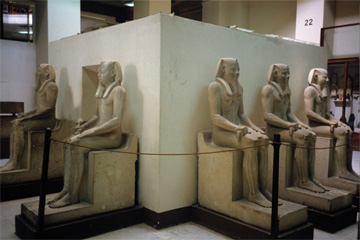
|
| Statues of Pharaoh Sesostris I found in a pit near his tomb are arranged around his reconstructed shrine in the Cairo Museum. |
Under Sesostris I, the second pharaoh of the Twelfth Dynasty, there was a man with unusual authority. His name was Mentuhotep and he appeared to exercise all the power of a pharaoh. His magnificent tomb was next to the royal pyramid at el-Lisht and was decorated with painted reliefs and statues, all of which were broken, together with one of the two sarcophagii. Curiously, he does not refer to himself in the tomb as "vizier", only "treasurer", but he also erected a Stele at Abydos on which are long strings of titles, including that of "vizier".
It has been suggested that Mentuhotep is Joseph, for the titles and the authority given to Mentuhotep mirror closely those granted to Joseph. Even the fact that one sarcophagus was destroyed and the other preserved virtually intact has been cited in support of this theory - Joseph's own sarcophagus was destroyed but that of his Egyptian wife was spared.
Against these circumstantial evidences we have to place the fact that Mentuhotep never even mentions a famine, which would be curious in view of the part the famine played in bringing Joseph to power. In addition Mentuhotep was "Overseer of All Royal Works" and appears to have been the main architect of the Amun temple of Karnak, which some might think precluded him being a Jew as presumably a servant of God would have no part in building an idol temple. This, however, is not a conclusive argument, as we cannot be sure exactly how the descendants of Abraham viewed their duty; Joseph may have felt that all that was prohibited was to worship other gods and overseeing the building their temples was permitted.
Finally there is the difference in names. According to Genesis, Pharaoh gave to Joseph the name "Zaphenath-pa-aneah". Considering the way in which Manetho mangled Egyptian names, there is doubtless a genuine Egyptian name in there, but it is not "Mentuhotep"! However this is not an insurmountable problem. Egyptians commonly had more than one name - we might use the example of a man called Robert Samuel Williams, who will be known to different people as "Bob", "Rob", "Robert", "Mr Williams" or even "Mr Robert S. Williams". We might call one his pet name, another his family name, another his friends name, and another his formal or work name.
In the same way pharaohs and other officials had more than one name. Even worse, the same name could be read in different ways, so Sesostris could be read as Usertasen, Usertsen, Senwosert, Sesusi, Sesonchis, and Senusert. Dr Courville, in The Exodus Problem and its Ramifications, points to a certain Prince Yufni and advances reasonable arguments for reading the name as "Prince Yusef", though I fear that he ignores the fact that Joseph would have been known to the Egyptians as "Prince Zaphenath-pa-aneah"!
So far no such person has been found and if he is not to be identified with Mentuhotep, then we can conclude that, like so many other Egyptians who fell out of official favour, his monuments have been broken and all occurances of his name have been erased.
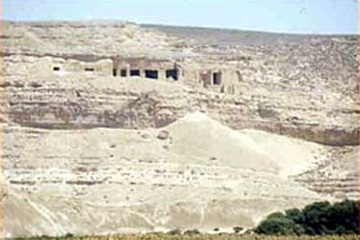
|
| The tombs of the Nomarchs at Beni Hasan stand on an artificial terrace high above the river. |
At Beni Hasan, twelve miles south of Minya, there is a row of 39 Twelfth Dynasty tombs of the nomarchs of the Oryx Nome, four of which are open to visitors. Tomb 2 is that of Ameni and contains the famine inscription; Tomb 15 belonged to Baqet II and if famous for its fresco of wrestlers, illustrating wrestling holds and throws. The third, Tomb 3, belonged to Knumhotep II and contains within it the famous fresco of Asiatics entering Egypt which appears at the top of this page. On the basis that only the arrival of someone as important as the vizier's father would be commemorated, some have tried to argue that the fresco depicts the arrival of Jacob and his family.
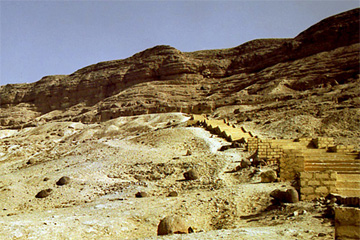
|
| Modern steps lead up to the tombs of the Nomarchs at Beni Hasan. |
Khnumhotep live early in the Twelfth Dynasty, holding the office of Overseer of the Eastern Desert from the 19th year of Amenemhet II to the 6th year of Sesostris II. If the incident of the arrival of the Asiatics occurred during his overseership and if Mentuhotep is Joseph, then this cannot be the arrival of Jacob and his family. Indeed, the accompanying inscription identifies the leader of the group as Absha, Sheikh of the Aamu.
However, although the group has no direct Biblical connections, it may be taken as typical of the sort of people who were immigrating into Egypt and the colourful garments worn by both sexes probably illustrate the infamous "coat of many colours" that caused so much trouble between Joseph and his brothers.
During the Twelfth Dynasty a depression south-west of Cairo was opened up for agriculture. Known as the Faiyum, this area, which lies below sea-level, receives its water via a canal from the Nile. The original canal was ten miles long and ran from the nearest point on the Nile, through an opening in the cliffs that line the river, to the centre of the Faiyum. Water only flowed into the Faiyum at the height of the annual flooding of the Nile and there was some flow out as the level of the river fell, thus evening out the effect on the flood on the Delta.
In more modern times a permanent inflow of water is assured by a longer canal that leaves the Nile at Assiut and gradually diverges from the river until it reaches Bani Suef, at which point it passes through the gap in the cliffs and enters the Faiyum. This canal is known to modern Egyptians as Bahr Yusuf or "Joseph's Canal", though the source of the name is not known.
The original canal may have been dug during the reign of Sesostris II, as it is known that he took a great interest in the Faiyum and constructed a network of canals in the area of el-Lahun. On the other hand it is possible that Sesostris II merely extended a work already begun under Sesostris I, whose obelisk stands in the centre of al-Faiyum, the largest city in the oasis.
Some have suggested that Joseph was responsible for opening the Faiyum to agriculture as part of the measures taken to ensure the maximum harvest during the years of plenty. If so, it must have been a massive undertaking and Joseph has to be admired for coming up with the idea and executing it during what must have been a very busy seven years! A more likely scenario is that a natural channel which occasionally flooded was deepened and the marsh in the Faiyum drained as part of a project of public works by which the people of Egypt could be given an income and food during the seven years of the famine.
The final chapter of Genesis refers to seventy days during which the Egyptians mourned for Jacob. This was the standard time taken for embalming a corpse and turning it into a mummy - and as the text explicitly mentions embalming, we are safe in assuming that Jacob was turned into a mummy. Unfortunately the mummification process was not proof against damp conditions and many mummies in Egypt have been damaged or destroyed when water leaked into the tomb. The Cave of Machpelah is very far from being water-tight, neither has it been as secure as the tombs of Egypt, so between damp and human intrusion, it is not at all surprising that nothing remains of the burials in the cave.
It is interesting to speculate over Joseph's ill-judged social experiment of making pharaoh owner of all the land in Egypt. By putting all power into the hand of the king Joseph certainly gained royal favour, but it is quite possible that he also aroused great hostility among the lower classes - and that hostility may have played a part in the eventual enslavement of Joseph's brethren! Instead of being viewed as the deliverer of Egypt, Joseph and his kin came to be viewed as the enslavers of Egypt.
It is entirely natural that Joseph should work for the advantage of pharaoh, his benefactor, but looking forward a little his actions resulted in disaster for the land of Egypt and the eventual death of another pharaoh and of his firstborn. In other words, no matter what personal obligations there may be, those in power must always work to benefit all those over whom they exercise power. Injustice towards one part of society will always result in harm and loss, for the society as a whole and even for those who apparently benefit from the injustice.
The culmination of this process of concentrating power came under Sesostris III, who stripped the Nomarchs of their independance and introduced other changes that made the king more powerful. It is probable that it was at this time that the Children of Israel lost the privileged position they had gained under Joseph and were, gradually or suddenly, reduced to slavery. It is likely, therefore, that Sesostris III was the first pharaoh of the oppression.






